


The TRACE images may be used without restrictions
in publications of any kind. We
appreciate an acknowledgement indicating that
the Transition Region and Coronal Explorer, TRACE,
is a mission of the Stanford-Lockheed Institute for Space
Research, and part of the NASA Small Explorer program. More information on
TRACE and other TRACE images can be found
here.


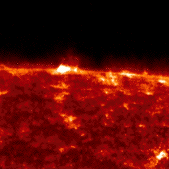 |
On the polar limb:The images on the left show two observations of the Sun's north polar region taken in 2006/08/15 and 2006/08/17, respectively. They show 28s-long exposures in the TRACE 1550Å channel (negative for 08/15, positive for 08/17) which reveal the faint spicules off the solar limb. These QuickTime movies (1, 2) show their dynamics in response to the moving magnetic concentrations on the solar surface. The 2nd movie also shows a small flare/eruption in which the field of a small ephemeral region destabilizes on the solar pole much like its much larger active-region counterparts do at lower latitudes. |
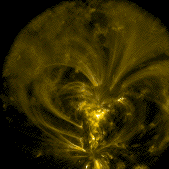 |
Active Region 10904, observed by TRACE in its 171Å channel on
2006/08/14 at 15:55:37 UT, displays a beautiful array of magnetic loops.
In this image, rotated clockwise by 90 degrees so north is to the right,
has a large leading sunspot (at the bottom of the image) and a somewhat
fragmented spot group in the trailing (top) polarity. In between lies
the 'moss', the transition region below the hot internal loops of the region.
That is surrounded by well-defined, thin, loops, primarily highly inclined
from the normal to the surface, showing up in perspective to the left
and right of the central strong magnetic plage. The mottled, low quiet-Sun
corona surrounding the active region can be seen through the higher loops.
 |
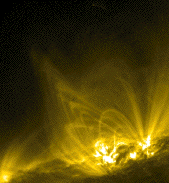 |
Active region 10904 emerged onto the solar surface before it rotated
onto the front where TRACE could observe it. But it continued to grow
once on the Earth-facing side of the Sun, with loops seen expanding
with time in a multi-day series of observations in the 171Å
(~1 million degrees) passband. In this image, taken on 2006/08/09
at 23:55:05 UT (rotated clockwise by 90 degrees so that north is to the
right), a series of loops can be seen ending in cusps, likely because
they reach a separator where the connectivity of the field changes, opening
above it
into a much larger domain (if not even into the heliosphere). Note also
the very compact flare in the core of the region, revealing itself in the
diagonal diffraction pattern that repeats the brightest kernels a few
times; this kernel is so compact that its size in the image is limited
by the TRACE resolution of one arcsecond (or 725 km on the Sun).
 |
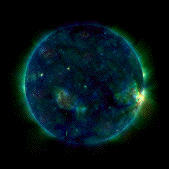 |
The big picture IVTRACE's field of view covers only a fraction of the entire Sun, but by repeatedly repointing, it can create an image of the entire solar corona. This three-color image shows the solar corona on 2006/08/05 in three extreme ultraviolet channels simultaneously: the 171Å channel (most sensitive to emission from 1 million degree gases) in blue, the 195Å channel (1.5 MK) in green, and the 284Å (2 MK) in red.The image (rescaled to 1500 by 1500 pixels to a side) shows a very inactive corona as the sunspot cycle winds down into a minimum; only a few small, relatively faint regions remain on the disk and at the limb. Most of the solar surface is now covered with compact ephemeral regions, and a few coronal holes (including the polar cap holes). Little material at 2 million degrees or above is present; hence the 'cool' blue-green look. Note some of the image artefacts: some high-energy particle impacts have left their imprint in a bright pixel noise seen, for example, in the 284Å (red) channel near the north pole and in the 195Å (green) channel off the limb; some readout interference noise shows up as green striping (particularly in the weak off-disk emission); and weak absorption in the Earth's atmosphere that occurs during some phases of TRACE's orbit cause some patches to look dimmer than others, causing the edges between the different panels to be visible for several of the 26 pointings needed to complete this image. P.S. There is also a 4.6MB 4500x4500 pixel version of this image. Other 'big-picture' full-disk mosaics in the TRACEpod collection
can be found here:
1,
2, and
3.
|
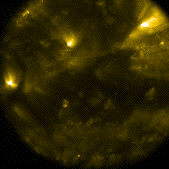 |
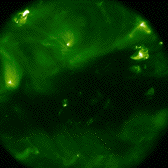
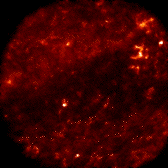 Coronal holes are regions with low coronal temperature and density that correspond to large-scale unipolar magnetic regions. TRACE observed an isolated equatorial coronal hole on April 30, 1999 in the 284Å (right), 195Å (center), and 171Å (left) channels. Each high-resolution image (shown binned 2x2 to 512x512 square images) offers a unique view of the interface between the regular, mixed-polarity, quiet-Sun corona and the coronal hole. TRACE 171Å (yellow) shows low-lying structures near the edges of the coronal hole. The 195Å (green) passband reveals much higher, diffuse plasmas and begins to resemble what one would expect to see in soft X-rays. However, the TRACE 284Å (red; weakly emitting and therefore noisy) bandpass can be deceptive for quiet Sun observations (Brooks & Warren, 2006, ApJ v 164) where He II (304 Å) may dominate the emission. The quiet-Sun network that typically is seen in He II is suppressed inside the coronal hole. Courtesy Trish Jibben (SAO).  |
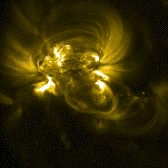 |
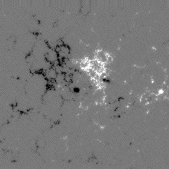
This image pair compares a coronal image taken by TRACE (171Å, on 2006/07/01 at 10:04 UT) with the underlying magnetic field as observed by SOHO's Michelson Doppler Imager (MDI at 09:14 UT; alignment and place scales are approximate). The TRACE image reveals the various connections between the black and white polarities, which are more confused than normal because of new magnetic field emerging in the righthand (leading) side of the active region. Courtesy Zoe Frank (LMSAL).  |
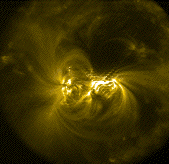 |
The M1.8 flare observed by TRACE on May 17, 2005
in this QT movie (13MB)
was not very
energetic but its influence on the corona can clearly be seen in this
TRACE 171 movie. AR10763's smaller southern loops behave much like a
plucked string while a larger loop north east of the active region
wobbles in response to the disturbance
(see the bottom of this page for a growing list of such
oscillatory phenomena). The flare caused a small
transient coronal hole, also known as coronal dimming, just south of
the active region that can be seen in EIT 195. To view more data about
this flare and other flares observed by TRACE, including EIT 195Å and
LASCO movies visit the website
http://hea-www.harvard.edu/trace/flare_catalog/.
Courtesy of Trish Jibben (SAO).
 |
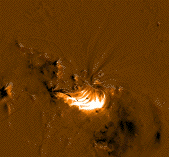 |
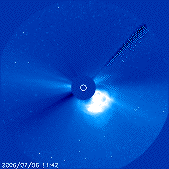
This QT movie (4MB) (courtesy Dawn Myers, GSFC) shows the filament eruption that was part of the M2.5-class flare observed by TRACE in its 171Å channel on 6 July 2006. The movie (8-10UT, at 80s cadence) shows the initial activation of the filament. As it begins to erupt, flare ribbons show up in the NE and SW at 08:22 UT. We believe these ribbons to be caused by the interaction of the overlying field with the erupting filament field. As the overlying field is forced out of the way, the footprint of that evolving field is outlined by the rapid expansion of the ribbons into irregularly shaped rings. The transition region emission from below hot loops within these rings fades away, leaving dark patches of, presumably stretched or opened magnetic fields. The image to the left summarizes this in a difference between images taken at 08:16 and 09:02UT: the brightened post-flare loops lie between two dark (dimmed) patches outlined by the residual flare ribbons.The associated CME in progress is shown in the LASCO C3 image above.  |
 |
The main sunspot in Actie Region 10898 is surrounded by activity in
this image taken by TRACE in its 171Å passband on 5 July 2006,
at 09:45 UT. A fan of relatively cool (1 million degree) loops
spans the northwest (upper right) quadrant of the spot. Under it,
a filament is active at multiple locations: a small eruption is
in progress at the lefthand edge of the fan, a set of post flare
loops is cooling south of the fan, while there are multiple
dark fibrils visible at the base of the loop fan with bright
ridges at their upper ends. The spot is surrounded by relatively
hot coronal gases, largely invisible to TRACE, but the cooler
interface (transition region, also known as 'moss')
to the lower atmosphere shows up
in a multitude of structures throughout much of the image. Many other
filaments/fibrils of a range of sizes show up southward of the central spot.
 |
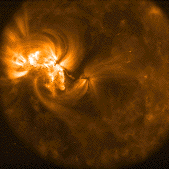 |
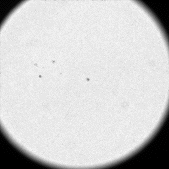
Active Region 10897 is a small region with only a handful of magnetic pores (see the image on the right taken in white light; note that the dark corners are caused by vignetting by the TRACE filter wheel - the Sun is almost four times wider than the field of view). The corona (seen in the TRACE 171Å channel, mostly sensitive to emission from million-degree gases) shows loops connecting the various pores and the surrounding magnetic fields. In this phase of the solar cycle, no more than one or two of such regions exist on the solar surface, keeping the overal -X-ray brightness low, with only low-level flaring (see the GOES X-ray light curves here). Courtesy Dawn Myers (GSFC).  |
|
| Home | Mission | Instrument | Team | Operations | Results | Images | Movies | Education | Site Info. | |